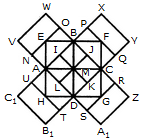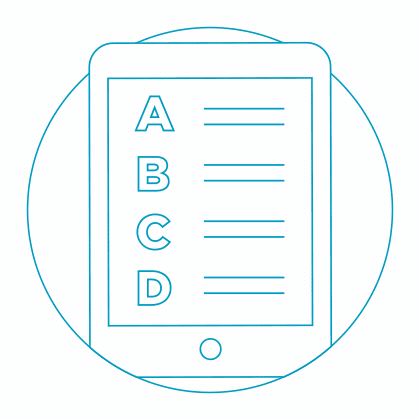REASONING - Online Test
Consider the following matrix:
| 3 | 370 | 7 |
| 2 | 224 | 6 |
| 1 | 730 | X |
What is the number at ‘X’ in the above matrix?
How many triangles and parallelograms are there in the following figure?

The figure may be labelled as shown.

Triangles:
The simplest triangles are KJN, KJO, CNB, OEF, JIL, JIM, BLA and MFG i.e. 8 in number.
The triangles composed of two components each are CDJ, EDJ, NKO, JLM, JAH and JGH i.e. 6 in number.
The triangles composed of three components each are BKI, FKI, CJA and EJG i.e. 4 in number.
The triangles composed of four components each are CDE and AJG i.e. 2 in number.
The only triangle composed of six components is BKF.
Thus, there are 8 + 6 + 4 + 2 + 1 = 21 triangles in the given figure.
Parallelograms :
The simplest parallelograms are NJLB and JOFM i.e. 2 in number.
The parallelograms composed of two components each are CDKB, DEFK, BIHA and IFGH i.e.4 in number.
The parallelograms composed of three components each are BKJA, KFGJ, CJIB and JEFI i.e.4 in number.
There is only one parallelogram i.e. BFGA composed of four components.
The parallelograms composed of five components each are CDJA, DEGJ, CJHA and JEGH i.e.4 in number.
The only parallelogram composed of six components is CEFB.
The only parallelogram composed of ten components is CEGA.
Thus, there are 2 + 4 + 4 + 1 + 4+ 1 + 1 = 17 parallelograms in the given figure.
(Here note that the squares and rectangles are also counted amongst the parallelograms).
Count the number of squares in the given figure.

The figure may be labelled as shown.

The squares composed of two components each are BJMI, CKMJ, DLMK and AIML i.e. 4 in number.
The squares composed of three components each are EBMA, BFCM, MCGD and AMDH i.e. 4 in number.
The squares composed of four components each are VWBA, XYCB, ZA1DC and B1C1AD i.e. 4 in number.
The squares composed of seven components each are NOJL, PQKI, RSLJ and TUIK i.e. 4 in number.
There is only one square i.e. ABCD composed of eight components.
There is only one square i.e. EFGH composed of twelve components.
Total number of squares in the figure = 4 + 4 + 4 + 4 + 1 + 1 = 18.
